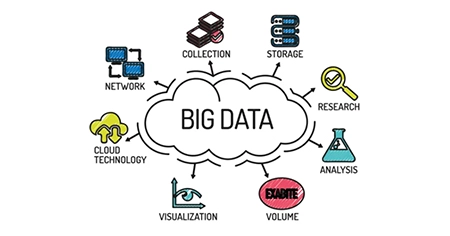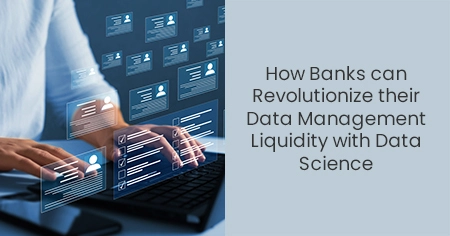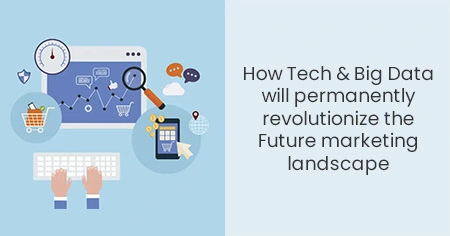Statistically, the financial analytics market is steadily growing. It is expected to reach an impressive 22.09 billion by 2032, with a CAGR of 11.57%.
This cutting-edge approach has helped banks refine and modernize their operations while also setting new standards in client service. Data science and banks can create personalized experiences by analyzing customer behavior, transaction histories, and preferences. This article will discuss how banks can Revolutionize their Data Management Liquidity with Data Science.
What Is a Big Data Wave in Banking?

In the banking industry, data analytics is more than a tool; it is a powerhouse that converts massive amounts of data into insights that banks can use. It's all about sifting through data to find patterns and trends influencing major financial decisions.
Given how quickly things change in the banking industry, not to mention all of the regulations, real-time data analysis is essential. It is not enough to keep up; banks must be one step ahead, making smart, timely decisions.
Consider how banks now use data analytics to streamline operations and improve customer interactions with their services. Understanding how customers behave and conduct their transactions enables banks to fine-tune their offerings, ensuring they meet customer needs effectively and efficiently.
How Banks Can Revolutionize their Data Management Liquidity with Data Science:
Are you curious about how banks use analytics to their advantage? Here are some benefits they use to ensure that liquidity management runs smoothly.
- Understanding Customer Behavior

Predictive analytics and machine learning algorithms analyze large amounts of data to identify customer behavior patterns. They identify patterns, preferences, and behaviors unique to each customer. Based on transaction histories and interactions, these algorithms can detect spending habits, preferred banking channels, and specific financial goals.
- Enhancing Regulatory Compliance
Banks are subject to complex and ever-changing rules. Data Science and banks help to monitor transactions and ensure compliance with anti-money laundering (AML) and Know Your Customer (KYC) regulations. They also help to create detailed audit trails, which are necessary for demonstrating compliance with regulatory agencies.
- Personalized Customer Experiences

The essence of banking is understanding and meeting customers' needs. By analyzing preferences, transaction histories, and customer behavior, data science allows banks to provide personalized experiences. Financial institutions can use this data to offer tailored products and services, increasing customer satisfaction and loyalty.
Personalization in banking has undergone a transformative shift with the incorporation of data science, allowing institutions to provide customized experiences that are deeply responsive to individual customer needs and preferences.
Historically, banks used broad approaches to providing services or recommending products to customers. However, data science has proven invaluable in extracting valuable insights from today's massive amounts of data, including spending patterns, demographics, transaction histories, and social media interactions.
- Optimizing marketing and sales
Financial institutions can leverage advanced tools to analyze profit and loss metrics more effectively. This can result in better customer retention and increased revenue. Banks can further enhance their strategic capabilities by exploring comprehensive data analytics in banking to gain deeper insights into their operations.
- Enhancing Customer Engagement

Banks increase customer satisfaction and loyalty by offering tailored solutions. Customers feel valued and understood when they receive services that are tailored to their specific needs. This personalized approach strengthens the customer-bank relationship, increasing loyalty and potential advocacy.
- Save valuable time.
Time is valuable. Investing in data analytics can simplify operations and save employees time. The ideal solution organizes data and eliminates spreadsheets, reducing gray space in any organization.
- Understanding Customer Behavior
Employees can easily find what they're looking for, allowing them to focus on the institution's most critical tasks. Instead of organizing and sorting data, they can devote more time to analysis, strategic decision-making, and customer communication.
- Real-time decision-making
AI systems can process large amounts of data in real-time. This allows banks to make critical decisions more quickly, such as responding to market fluctuations, identifying and addressing liquidity issues, and handling customer inquiries.
- Secure Compliance, Risk Management Features
Data analytics enhances overall bank security. The regulatory environment for financial institutions is complex, and noncompliance can result in large fines or enforcement actions against banks.
- Improve performance

More time spent connecting with customers allows employees to understand their financial needs better, which improves the bank's overall performance. The right data analytics solution helps a financial institution become more productive and profitable. In today's increasingly competitive economic landscape, employee and customer experience are critical for all financial institutions. Customers expect seamless communication and secure, intuitive digital experiences, while employees value work environments where their efforts contribute to the company's overall success. Using data to its full potential enables banks to make better strategic decisions, identify and capitalize on growth opportunities, and prioritize their customers.
- Continuous Improvement
Data science enables banks to continuously improve their understanding of customer preferences. As more data is collected and analyzed, algorithms learn and adapt to improve the accuracy of personalized recommendations and services.
Conclusion
Data science is the basis of modern banking, reshaping the industry and enabling unprecedented innovation. Data analytics, machine learning, and artificial intelligence can help banks provide personalized experiences, mitigate risks, and drive operational excellence.








